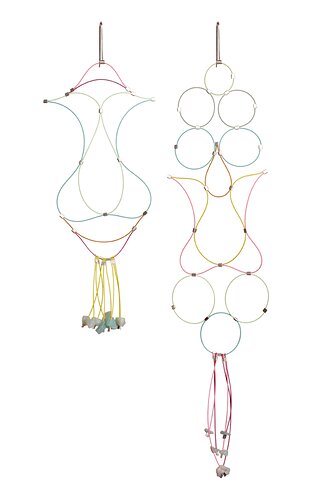Materials: Nylon-coated stainless steel cable, sterling silver, amazonite, quartz
Dimensions: 12" x 2.5" x 0.25"
The Mr. Potatohead earrings are from my series L'Age D'Or, as exemplified by the oversize neon-pastel "dress-up" earrings, has been an experimentation with the use of a bright palette reminiscent of my 80's beachy childhood translated in deco motifs to reflect a golden era of dress-up and play.
Photo credit: Toky Photography
Meghan P Riley
Meghan Patrice Riley
Brooklyn, New York. USA
I create light and kinetic, wire jewelry. With a background in math and geometry, each piece is inspired by volumetric forms and is fabricated by hand. Using sterling silver and gold fill tubing with nylon-coated steel wire as fiber; I am able to form small line segments to create geometric shapes and forms that are lightweight, flexible, and adapt to the wearer. Geometric shapes were chosen as the foundation because they are simple, basic, and elementary but can be expounded on to create multi-dimensional forms. Each form acts like a link to interconnect with other forms creating an even larger volumetric structure. The resulting pieces are extremely light, web-like structures that have glints of precious metal connectors amongst the flexible metal wire.
I love finding the intersection of art, design, and fashion- my collections have received numerous attention and awards in the fashion and art worlds. I have held solo art gallery shows nationally as well as winning the prestigious Raphael Founder Prize for innovation in small metals from the Society for Contemporary Craft. Additionally, I've been featured in a NYC runway shows which resulted in a semi-finalist position for the Ecco Domani Fashion Fund.
The exhibition explores metal works whose primary theme is color embraced as their primary visual focus, whether that be using colored materials, exploring creating colored surfaces, or encasing the object in color.
As the world's largest jewelry related internet site, Ganoksin strives to develop exhibitions showcasing work from around the world. This exhibition was open to all metalsmiths, professional and amateur, advanced and beginner.
In total 303 artists contributed 814 show pieces for the permanent online exhibition.
The exhibition was curated by Beth Wicker, President of the North Carolina Society of Goldsmiths in the United States, and Adjunct Instructor at Northeastern Technical College in South Carolina. Director of the exhibition is Hanuman Aspler, founder of The Ganoksin Project, the world's largest internet jewelry site.
Hue is one of the primary properties of color, it refers to the place the color occupies on the visual spectrum. Humans have used hues throughout time, to create cave paintings, to decorate themselves, their clothing and their housing.
Different hues have taken on different meanings throughout time. Gold traditionally has been a color of purity - the metal gold is relatively unchangeable, and the hue of gold has come to stand for gods and goddesses, for royalty, for durability and for purity. Red has often meant love, or passion. Hues often reflect the meaning of the seasons, with pastels referring to spring and the burst of new life after the pale hues of winter. Summer is reflected in vibrant, deep hues, followed by the browning of hues in the fall as plants go to seed and die, and the land turns fallow.
The worth of a hue has often been tied to what is necessary to make the pigment that creates the hue, and the expensive involved in the process. Often created from crushed stones that had to be mined and carried by caravan over thousands of miles, or from fermented roots of plants only grown in certain areas, or the carapaces of rare insects - the creation of hue in a way that could be used by man was an involved and generally expensive process.
In today's world metalsmiths have access to perhaps the widest range of materials and hues in the history of man - and in some of the most affordable ways ever.
This exhibition celebrates hue - color - as an integral, inherent element of the work. We talk of the "richness" of color, and examples of this abound here. One expects hues from the colors of gemstones used in metalsmithing, but we also have hues from some less expected places. Glass enamels are an ancient way of adding color, as are a variety of patinas. Today's artists also use synthetic man-made materials to add color in ways that didn't exist a century ago.
We invite you to enjoy this celebration of hue, and the ways hues and their use have changed over time.
